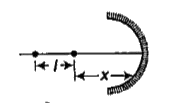(a) A short linear object of length b lies along the axis of a concave mirror of focal length f at a distance u from the pole. What is the size of the image? (b) If the object begins to move with speed , what will be the speed of its image?
a. According to mirror formula,
(i)
For a given mirror, focal length f= constant. Therefore, on differentiating, Eq. (i) gives
(ii)
Multiplying Eq. (i) throughout by u, we get
(iii)
Differential length of the object on the axis, (given).
Therefore, Eq. (ii) gives .
The negative sign shows that the image is longitudinally inverted.
Size of image .
b. From Eqs. (ii) and (iii),
Dividing both the sides by differential time dt, we get
Given adn speed of image (say)
Topper's Solved these Questions
- GEOMETRICAL OPTICSBOOK - CENGAGE PHYSICSCHAPTER - GEOMETRICAL OPTICSEXERCISE - Exercise1.1
14 Videos
- GEOMETRICAL OPTICSBOOK - CENGAGE PHYSICSCHAPTER - GEOMETRICAL OPTICSEXERCISE - Exercise1.2
20 Videos
- GEOMETRICAL OPTICSBOOK - CENGAGE PHYSICSCHAPTER - GEOMETRICAL OPTICSEXERCISE - Integer Type
4 Videos
- FRICTIONBOOK - CENGAGE PHYSICSCHAPTER - FRICTIONEXERCISE - QUESTION BANK
1 Videos
- GRAVITATIONBOOK - CENGAGE PHYSICSCHAPTER - GRAVITATIONEXERCISE - Question Bank
39 Videos
Similar Questions
A short linear object of length b lies along the axis of a concave mirror of focal length f at a distanee u from the pole of the mirror. The size of the image is approximately equal to
View SolutionA short linear object of length b lies along the axis of a concave mirror or focal length f at a distance u from the pole of the mirror. The size of the image is approximately equal to
View Solution
Knowledge Check
A short linear object of length b lies on the axis of a concave mirror of focal length F at a distance u from the pole. The length of the image will be
A(fu−f)bB(u−ff)bC(fu−f)2bD(u−ff)2bA short linear object of length / lies along the axis of a concave mirror of focal length f at a distance d from the pole of the mirror. The approximate size of the image is
AIf(d+f)Bd+ffICIf2(d+f)2DI(d+f)2f2A short linear object of length b lies along the axis of a concave mirror or focal length f at a distance u from the pole of the mirror. The size of the image is approximately equal to
Ab(u−ff)12Bb(fu−f)12Cb(u−f2)Db(fu−f)2
A very small object of length a is kept along the axis of a concave mirror of focal length y at a distance x from its pole. Approximate size of the image is
View SolutionA short linear object of length / lies along normal to the axis of a concave mirror of focal length f at a distance d from the pole of the mirror. The size of the image is then (nearly)

View SolutionA short linear object of length l lies on the axis of a spherical mirror of focal length f, at a distance x from the mirror. Then, the length of the image (P) so obtained will be

View SolutionWhat is the size of the image when a short linear object of length b lies along the axis of a concave mirror of focal length f at a distance u from the pole.
View SolutionA short linear object of length l lies on the asix of a spherical mirror of focal length f, at a distance x from the mirror. Then, the length of the image (P) so obtained will be

View Solution
